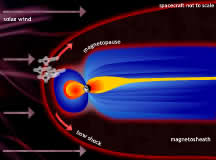
 |
| Figure 1: The earth's magnetosphere and the magnetopause. Click for a larger image. |
The region around the Earth that is controlled by the Earth’s magnetic field, called the Magnetosphere, acts for the solar wind as an obstacle, like a rock in a flowing river. Since the solar wind with a speed of 250 – 800 km/s is highly supersonic, the situation is more like a supersonic jet plane rushing through the air. As a jet produces the audible supersonic boom, a loud shock wave (to be heard after the jet has passed already the observer’s position), the Earth’s Magnetosphere produces the equivalent structure, the so-called Bow Shock, in the solar wind.
Such shock waves are formed in many places in the universe with violent motion, around planets, at the Sun, around the solar system where the solar wind is stopped, and where supernovae blast into their neighborhood. In all these cases these shock waves slow down the solar wind, compress the flowing gas or plasma and the magnetic field, heat it up, and accelerate some particles to very high energies. The Cluster satellites cross the Earth’s Bow Shock usually several times during orbits that lead into the solar wind. Thus they can study this shock wave at our front doorstep in detail.

|
| Figure 2: Cluster Data. Mouse over specific areas for more information, or click here for a written explanation. |
The composition "Rock Around the Bow Shock" has been computer-generated from data obtained during several consecutive crossings of the Cluster spacecraft through the Bow Shock. An overview of a subset of these data is presented on the figure at right. When an individual spacecraft crosses the bow shock, the event is indicated by a vertical line. They start out in the solar wind, as indicated by the high speed in the bottom panel; once they cross into the magnetosphere, the wind speed slows dramatically.
H+ Ion Flux: Spacecraft (sc) 1, 3, and 4 H+ flux data plays through three unique and distorted guitars. Each guitar plays a chord composed of three octaves plus one (16 notes) of a Pentatonic scale containing the intervals 3, 2, 2, 3, 2 starting from MIDI note 40. Each of the 16 notes represent 16 energy bins of the H+ ions signal. The data value in each energy bin at any one time controls the volume of the resulting notes in the chord.
All other data parameters play through unique instruments using an algerian scale containing the intervals 2, 1, 2, 2, 2, 1, 2. Unless otherwise stated, the notes start from MIDI note 28 and contain 45 notes, or six octaves plus three.
Magnetic Force: Spacecraft 1 plays through the timbre of a bass string pizzicato. Spacecraft 2 is played through and overdriven distorted guitar (with fifths). Spacecraft 3 is a string ensemble, and spacecraft 4 is played on melodic toms, techno hi-hat, and "vintage (organ) plunk." Musically, we obtain a sense of bass, some drums and percussion, some power from the guitar, and warmth from the strings. A nice balance.
Solar Wind Density: Played through woodwinds. Spacecraft 1 data is played on clarinet, spacecraft 3 on oboe, and spacecraft 4 on a sound inspired from "eastern europe" and doubled on pan flute. The notes start from MIDI note 52 and contain 22 notes or three octaves plus one. Here we use a much smaller range of notes so that the resulting sound is more natural. Notes are sustained and lowered in volume when the underlying data values stay the same.
Solar Wind Velocity: Spacecraft 1 is played on "ethno bells," spacecraft 3 on "puff 1080," and spacecraft 4 on "fantasy vox." Here we get sustained sounds and some vocal and sense of world music.
Temperature: Spacecraft 1 data is played through tubular bells. We can easily pick out this sound, whose data provides an environmental context.
Rhythm: is determined solely by the timing of when the data was collected by the various spacecraft.
Tempo: is set to four times real time. That is, there are about 5 minutes of music for 25 minutes of recorded data.